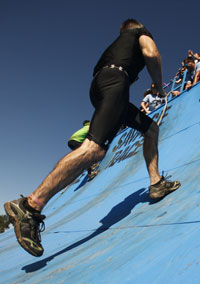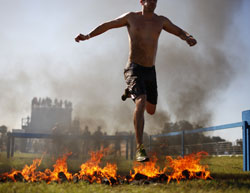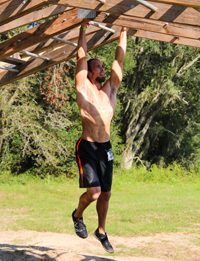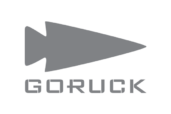Savage Footwear: Start With the Feet

by Art Waters of Sweat Life Fitness
Welcome back you filthy Savages! I hope that our Get Your Mud on Savage Style was helpful in preparing you all for the beat down of the October race in Dade City. I heard the 6-mile/25-obstacle course was epic and very well attended at 9,000+. I have signed up for the next Florida race and look forward to getting my ass kicked with you on April 13th. In order to help us better prepare our feet for the upcoming event, I have enlisted the help of some local racers to figure out what types of footwear are best to conquer mud run courses.
As you may or may not know, proper footwear can make or break your performance. While volunteering at the Gator Gauntlet, I saw dozens of racers cruise by with at least one missing shoe, probably not ideal for the North Florida terrain filled with roots, downed branches, and cinderblocks. I’ve also seen competitors attempting to conquer the final wall of the Superhero Scramble with no success due to lack of shoe traction. Therefore, it is extremely important to find proper footwear that allows you to successfully navigate the dynamic terrains of obstacle races.
This article is not a complete analysis of the shoe industry; it is designed to give you some knowledge and advice from real runners who have experienced triumphs, challenges, and mishaps. But as Sally Spooner (Super Spartan 2011: 1st place female overall) says, “There is no one shoe that fits all.” Listed below are the most popular shoe types I came across after getting input from Chris Pregony (Savage Race 2011: top 40- 7th in age group, Swamp Dash 2011: 8th place overall, Rugged Maniac 2012: 12th place overall, Swamp Dash Fall 2012: 1st place team Rugged Maniac 2013: 1st place overall), Matt Terza (Superhero Scramble 2012: 5th place overall -Scramble Gamble Wave, Swamp Dash Fall 2012: 1st place overall), Mike Carillo (Owner of Gainesville Running and Walking), and multiple members of the Running Man Club-RMC (Iron Crusader 2011: 1st place team and critical mass award, Swamp Dash 2011: 1st place team , Swamp Dash 2012: 1st and 2nd place teams, Rugged Maniac 2012: most rugged team, Savage Race 2012: 2nd place team, Swamp Dash 2012: 2nd place team, and dozens of individual honors).
Vibram FiveFingers
Unless you have been hiding underneath a rock for the past few years, you are familiar that these shoes look like gloves for your feet. Although they appear rather goofy at first glance, there is a rationale for them. According to Vibram’s website, running in FiveFingers allows your foot to land with a forefoot strike which enables you to land directly below your center of gravity. This results in efficient balance and stability with less impact. Karen Deshon (RMC) says, “you never have to worry about losing shoes in the mud, they are comfortable, and let your foot move and adjust to the specific obstacle.” Others including Cindy Miller Smith (RMC) and Karen Lindo Harbaugh (RMC, Rugged Maniac 2011: 1st place in age group, Rugged Maniac 2012: 1st place in age group, Savage Race 2012: 3rd place female overall, Warrior Dash 2012: 2nd place in age group) like them because they have excellent traction, don’t retain much water or mud, increase balance and agility, and are easy to clean up. There are several models of FiveFingers so be sure to purchase some with thicker more durable soles and better grip such as the TrekSport. As these shoes are minimalist, meaning there is very little support, Matt Terza says, “don’t wait until the day of the race to break in your FiveFingers because you may notice changes in your gait and experience early muscular fatigue.” Chris Pregony adds that, “you are setting yourself up for shin splints, sore calves, tendonitis, and other foot and ankle injuries with improper acclimation.” His strategy is to walk in the shoes normally before progressing to wearing them while exercising. Because people’s feet are shaped differently and running mechanics vary greatly, Vibram’s website suggests it can take weeks, months, or for some a year to get adjusted to FiveFingers.
Trail Running Shoes (New Balance Minimus)
Although there are multiple brands that make trail running shoes including brands such as Merrell and Inov-8 (partnered with Spartan Race in 2012, since then Spartan Race has partnered with Reebok), my experience and research have lead me to the New Balance Minimus. The New Balance website highlights that these shoes have a lower drop-4mm or less (difference between heal and toe height), wider toe box (allows foot to expand naturally), very lightweight (4.5-8 ounces), and are engineered to encourage a mid-foot strike. Andy Farina (RMC, Savage Race 2011: 4th in age group, Superhero Scramble 2012: day race 3rd place in age group, Swamp Dash 2x 1st place team and 1x 2nd place team) likes that they are designed to wear with or without socks, have 360 degree flexibility, and fit like a glove. I have personally worn them for 4 races as well as during many months of training and would recommend them because of their slipper like feel and breathability. I have read reviews that the traction is not great, but I have had no problems scaling multiple walls and obstacles in them. They do have an adjustment period similar to the Vibrams since they provide virtually no support. New Balance suggests wearing the Minimus for 10% of your workouts when you initially use them. Gradually increase your usage as your feet, calves, and ankles become acclimated to the shoes. One other issue with these shoes is that the outside fabric may tear over time (20V2 Trail). Consider testing the 20V2 Trail, 10 Trail, and Zero Trail models.
Cross Country Flats
These shoes are made by many different companies. They tend to have similar attributes compared to FiveFingers and Minimus such as being very lightweight, don’t absorb or hold much water, are breathable, and have little cushion in the heal. They differ in that these shoes are narrower and the sole can be quite rigid, which results in less shoe flexibility. Mike Carillo recommends these shoes for mud runs because they have been designed and utilized for many years to conquer varied terrain. Carillo says, “Depending if it has rained or how early in the morning a cross country race is, it can be very muddy. This is similar to a lot of the mud races.” Many reviews of these shoes praise their ability to maintain grip on challenging obstacles and their dependability to stay on your feet through thick mud. Another plus is that these shoes are quite economical; you should be able to purchase a pair for under $60 and sometimes under $40. There is an acclimation period with these as well so be sure to give yourself time to adjust to wearing them. Finally, because they tend to be narrow and a bit snug, you may consider buying a ½ size up. Start your research with Nike’s Zoom Waffle line or Saucony’s, Kilkennys or Shays. Be sure to purchase the spikeless version.
Running Shoes
There are some competitors that prefer to run in their regular running shoes. Sally Spooner says, “It is important to wear and use what is comfortable to you.” So, if you run best in true running shoes, you might consider wearing them for a mud run. You will have much more foot support compared to the minimalist types and probably more comfort. People with very flat feet who pronate greatly might not be able to wear a minimalist shoe; therefore a running shoe is a better option. Be sure to find a running shoe that has good traction as some feel quite slick during wet conditions, which is clearly not what you want on race day. Also, find a shoe that is lightweight and breathable. The last thing you want is a hot and heavy shoe that is bogged down with water and mud. Tim Donovan (RMC, Superhero Scramble 2012: day race 3rd place overall, Swamp Dash 2x 1st place team and 1x 2nd place team) raced in the initial Savage Race in 2011 in running/trail shoes, which he finished 6th in his age group. He says, “I accumulated water and mud in my shoes and it was very hard to maneuver.” Since then he has transitioned to a more minimalist shoe (Nike Free Run 2 & 3). Consider putting duct tape over your shoes and around the soles to keep mud out and help prevent them from being pulled off.
Savages, there you have it, lots of opinions from real racers who have grinded through dozens of courses and tested many shoes. Remember to use this information as a starting point to conduct your research and find out what shoes work best for your foot type, stride, and intensity level. If you are a one and done racer, you might as well find an old pair of yard work shoes to race in and donate them upon completion of the event. At this point there is no true mud run shoe, but Mike Carillo says, “mark my words, you will see a mud run specific shoe in the next few years, it just hasn’t come out yet.” In fact (while writing this article), Reebok recently released information that they are coming up with specific shoes for mud run athletes in the fall of 2013. Until then, find your happy shoes and get your mud on! Look out for more Savage articles coming soon.
Article By: Art Waters of Sweat Life Fitness, MA, NSCA-CSCS, NASM-CES
Rugged Maniac 2013: 2nd place overall
Superhero Scramble 2012: 4th place overall
Swamp Dash 2012: 1st place team









